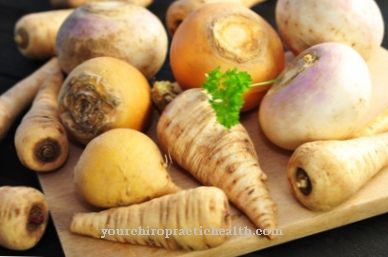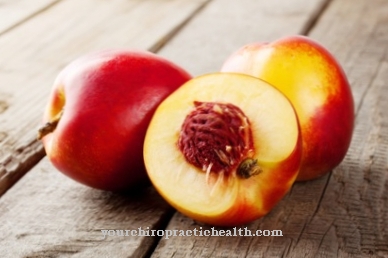In the immature state, it works Tomatillo like a small and green tomato and can be used like a vegetable in this state. It has a spicy aroma. When ripe it is yellow and then tastes much sweeter than a tomato. The tomatillo that mexican berry fruit, is not closely related to the tomato but to the physalis and also has a paper-like shell.
What you should know about the tomatillo

The tomatillo, which belongs to the nightshade family, comes from Mexico and Central America. Here it serves as the basis for many dishes, especially for a green salsa sauce. But the fruits are also eaten raw, fried or cooked.
The Tomatillo is an annual, herbaceous plant that can reach a height of two meters. The hollow stem is slightly angular and branched. The tomatillo has little or no hair. If the plant is not adequately supported it will cause it to tip over and continue to crawl on the ground. The seeds germinate after about seven to ten days. The young seedlings initially develop only a weak taproot. In adult plants, however, this develops into a flat, widely branched root system.
In the further growth of the Tomatillo, adventitious roots form. When these reach the ground, they grow into it and thus form an independent root system. The stem axis is branched. This is where the flowers develop. The plant is self-sterile. This means that it can only be pollinated by the pollen from the other plants. Pollination occurs primarily by insects. The fruit of the tomatillo is a small, spherical, green or green-purple berry. This is enclosed by the calyx. After fertilization, this paper-like shell is formed by enlarging the sepals. The fruit itself forms inside the shell.
During the maturation it fills this out. The tomatillo can be about the size of an apricot. It takes 50 to 70 days from pollination to this size. Often it is even broken open. The skin turns brown and the color of the fruit becomes increasingly yellowish. Inside there are many small, round, flat seeds that are about one to two millimeters in diameter. The seeds are enclosed in a pulp. The consistency is reminiscent of apples and the sweet and sour taste of gooseberries.
With its fruity and fresh taste, the tomatillo is a popular ingredient for raw and cooked salsa as well as for Mexican stews. Tomatillo is usually only available in cans in Germany. The plant can also be grown in your own garden.
Importance to health
The Tomatillo provides the body with important vitamins, minerals and essential nutrients. This is important to enable the immune system and numerous body functions to function properly. The vitamin A contained is important for the eyes, skin and mucous membranes, for example.
Vitamin C is involved in building connective tissue and intercepts the harmful free radicals in the body. Vitamin C also promotes the absorption of iron and helps to render carcinogenic nitrogen compounds from food harmless.In Mexico's natural medicine, the pods are boiled and the resulting brew is administered in the case of diabetes. The Tomatillo should also be able to lower a fever and also to stimulate the flow of urine.
Ingredients & nutritional values
The Tomatillo has many valuable ingredients. In particular, the content of the important vitamins A, C and vitamins of the B group as well as the valuable minerals and trace elements potassium, calcium, iron, magnesium, phosphorus and sulfur make the tomatillo a healthy food.
Intolerances & allergies
Since the tomatillo is a nightshade plant, people with some diseases should avoid consuming it. Nightshade plants are said to have inflammation-promoting properties due to the alkaloids they contain, which is said to aggravate diseases such as arthritis, rheumatism and lupus as well as other painful musculoskeletal disorders. As soon as nightshade plants like the tomatillo are heated, the alkaloids are reduced by 40 to 50 percent.
Shopping & kitchen tips
The tomatillo is harvested from July or August. This is possible until the first frost sets in. The fact that the fruit is ripe is shown by the fact that the paper-like shell bursts open. Small fruits should be chosen when shopping because they are sweeter than the larger ones.
The condition of the skin is a good indicator of the freshness of the fruit. Ideally, the tomatillo is firm and has no defects. The shell should be green. If the fruit is not going to be used immediately, it is advisable not to remove the pod. It can either be stored on the counter or in the refrigerator, but should never be placed in an airtight container. Tomatillo can be kept for a week in the vegetable drawer or at room temperature.
The Tomatillo can also be frozen in sachets so that you can have them all year round. Before doing this, they are cut into slices, blanched and left to cool. The tomatillo is very easy to cook as it does not need to be peeled. It is only washed before use, as the tomatillo is covered with a sticky substance.
Preparation tips
The Tomatillo can be used very versatile. It is particularly indispensable in Mexican cuisine. It is possible to consume the tomatillo as a fruit or vegetable. If you want to eat them raw, you can halve them, add sugar or, if necessary, refine them with salt and pepper and then enjoy them with a spoon, as you would with a kiwi.
But also as a healthy side dish to various meat dishes, in a spread, in sauces and chutneys or due to the sour, spicy aroma in salads, the Tomatillo goes wonderfully well. If it is harvested and processed unripe, it colors sauces a beautiful green, making it a main ingredient in the preparation of salsa verde, for example. A tasty preparation option is also the cooked tomatillo in a hearty soup or a stew. It gives salsas etc. a slightly creamy consistency.
Therefore, the Tomatillo can replace thickeners well. It can be roasted to intensify the aroma. In a dessert, the tomatillo tastes especially good as a compote, jam or with ice cream. Even if it is often suspected, the tomatillo cannot be replaced by a green tomato in recipes, as the taste and consistency are not comparable.























.jpg)



